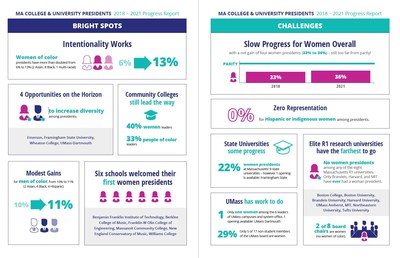BOSTON , June 15, 2021 /PRNewswire/ -- When it comes to higher education leadership in the Commonwealth, there is good news: the number of female college and university presidents is increasing, women of color have more than doubled over the past three years, and six institutions have welcomed their first women presidents. It's evidence that intentionality is working, according to the Massachusetts College and University Presidents Progress Snapshot, which followed the hiring of presidents from 2018 to 2021. The update was issued Monday by the Women's Power Gap Initiative of the Eos Foundation.

"We cannot emphasize enough how significant these gains are," said Andrea Silbert , President of Eos . "Bringing attention to the underrepresentation of women and BIPOC leaders in 2018 and working in partnership with a dedicated group of college and university presidents over the past three years has led to significant gains, particularly for Black women leaders. We are trending in the right direction, but there is still much work to be done."
The progress report is an update from the Women's Power Gap first report which ranked all colleges and universities in Massachusetts according to gender and racial representation in top leadership positions.
Among the gains made during the past three years:
- Women of color presidents have more than doubled from 6% to 13%
- Number of women presidents has increased overall from 33% to 36%
- 40% of community college presidents are women ; 33% are people of color
- Six schools welcomed their first women presidents
While work needs to be done to boost female leadership in the Commonwealth's higher education landscape, the Eos Foundation and its partners believe power parity is within reach and attainable with conscious, concerted efforts and an intentional shift in outreach, recruitment, and hiring practices.
"Having spent more than 30 years in academia, including the past 10 years as President of Emerson College, I 've been proud to partner with Eos on the Women's Power Gap Initiative since its beginning," said Lee Pelton , who co-hosted a 2019 summit on gender parity in higher education with the Eos Foundation , and who recently became President and CEO of The Boston Foundation. "This is a critical issue, not just for school leadership, but also for its present and future stakeholders."
The findings were shared during a private virtual summit on Monday among college and university presidents, provosts, and board chairs. Titled " Meeting the Moment - Higher Education's Opportunity to Lead the New Workplace ," leaders discussed the progress made in the leadership landscape. The group also talked about reimagining a more equitable workplace for women and men who are balancing demands of work and home, and how they might utilize the information gained from the summit.
"Higher education has the opportunity to seize this moment and assume a leadership role in shaping the post-pandemic workforce," said Simmons University President Lynn Perry Wooten . "It is crucial that we design enhanced support systems that help with employee reentry, retention, and promoting a sustainable work-life balance. This includes initiatives such as flexible work arrangements, mentoring programs, alternate career paths for tenure and promotion, and support for diverse types of scholarship."
"The pandemic unearthed numerous equity issues across all sectors," said Holyoke Community College President Christina Royal . "We responded during this pandemic by providing all employees the flexibility of reducing hours, taking leave of absences and also a remote work environment. As Holyoke Community College transitions back to campus, we will continue to re-evaluate the needs of the students and the employees and engage in conversation with the respective units to determine the ways in which we will adjust to a post-pandemic environment."
The 2018-2021 Progress Report can be found here .
About the Women's Power Gap Initiative of the Eos Foundation: The Women's Power Gap Initiative aims to dramatically increase the number of women from diverse backgrounds among CEO and C-suite leaders nationally. We conduct and commission actionable research on prominent sectors of the economy and measure the extent of the power and pay gaps at the company or institutional level to highlight those making fast progress, and those falling behind.
Contact:
Lealah Fulton
lfulton@thecastlegrp.com
617.980.6391
 View original content to download multimedia: http://www.prnewswire.com/news-releases/new-report-shows-significant-increase-in-number-of-women-of-color-leading-massachusetts-colleges-and-universities-301312857.html
View original content to download multimedia: http://www.prnewswire.com/news-releases/new-report-shows-significant-increase-in-number-of-women-of-color-leading-massachusetts-colleges-and-universities-301312857.html
SOURCE Eos Foundation